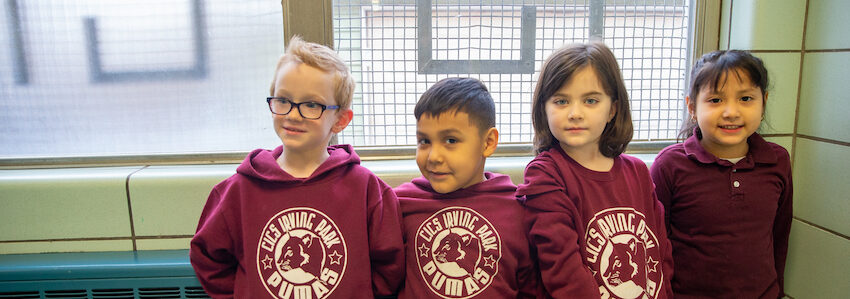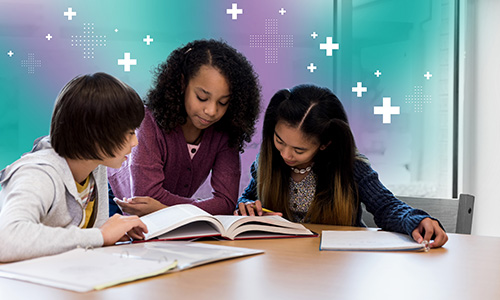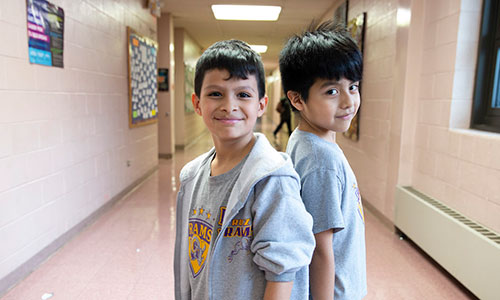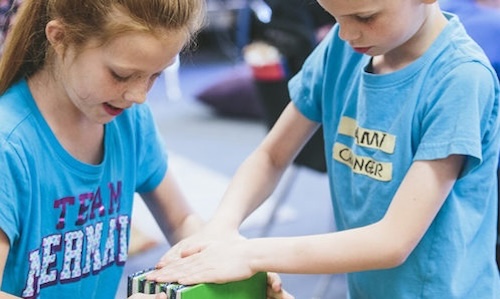
In many discussions on the science of reading, phonics is featured on the main stage. This is most likely because, unlike language comprehension, word recognition is a constrained skill—one with a limit—that can be mastered, typically within a few years of initial teaching. However, if we don’t pay attention to the bigger beast of language comprehension from the earliest grades, students without this opportunity will fall further and further behind their peers. We need to rethink our approach to teaching reading comprehension.
We think about reading comprehension as the product of word recognition and language comprehension. Nationally, we’ve done a great job getting the word out on the importance of phonics. This is, arguably, the easiest part of the equation to get right. However, that’s not all that needs to happen in the early years so students are successful readers later on.
Two pathways to teaching reading comprehension
We at NWEA recently spoke with Natalie Wexler, an education writer and author of The Knowledge Gap: The Hidden Cause of America’s Broken Education System—And How to Fix It. Natalie reminds us that “We really have to see literacy developing along two pathways that are going to be, to some extent, pretty separate in the early years.”
These pathways are word recognition and language comprehension. While phonics has a mound of intervention research on how to effectively get students to reading fluency, cognitive science tells us that students need to acquire plenty of knowledge to be able to understand the texts they encounter, and that this must start early on. Otherwise, the opportunity gaps between kids with experiences to gain background knowledge and kids without will only grow wider.

Natalie highlights how students “are going to be acquiring those foundational skills [of phonics and decoding] through decodable readers and practicing fluency.” But she adds, “That’s not how they’re going to be acquiring new knowledge and vocabulary of a new topic… That’s really going to come through this other pathway, which is reading aloud text that’s probably more complex than they can read themselves and engaging them in discussion of that content.”
In the early years, these pathways to becoming a reader are largely separate. Younger students or older readers with decoding difficulties won’t yet be able to read texts that are building their vocabulary and knowledge. They need to have these rich and complex texts read aloud to them. What does this mean for educators? Both paths need to be effectively taught for the best chance of literacy success in the upper elementary grades and later in life. One doesn’t come before the other—decoding and comprehension both must be valued in the early grades—and both must have adequate instructional time devoted.
What is reading comprehension?
Natalie says, “we have to think of reading comprehension as a process.” Sometimes you may hear teachers asking comprehension questions about a text to students. This is thinking of comprehension as a product, not a process. Assessing students’ comprehension of a text by asking them questions is not the same as teaching students to comprehend.
Comprehension is a metacognitive skill, one that is developed through purposely choosing text sets to build knowledge and leveraging specific reading comprehension strategies to help students acquire this knowledge and apply these metacognitive skills on their own.
So how do we go about building knowledge?
Reading strategies should not be the focus of teaching reading comprehension. Instead, they should be used in service of teaching students new content. The most recent research suggests we use three strategies to help students learn the content of the texts they are reading. Specifically, when combined with instruction in vocabulary and background knowledge, these strategies are most helpful in building student knowledge and understanding. We can teach students to:
- Identify the text structure
- Using the text structure, identify the main idea
- Summarize a text by expanding on the main idea
If students can summarize a text, they now have a situation model to work from. Think of it like helping them build a web of Velcro that all the details in the text can stick to. Teaching students to use these steps will help them build the metacognitive muscles they’ll need to do this type of understanding on their own. By helping students arrive at a coherent understanding, teachers position readers to do the deep work of making inferences, generating questions, and making connections.
Imagine, for example, a class of first-grade students learning about animals and their habitats in science. They read an informational text about owls. Their teacher may then plan to use the book Owl Moon by Jane Yolen to help students step into the role of the child protagonist who is going owling for the first time. Their teacher may refer to what the students learned about owls’ eyesight and sleeping patterns from the informational text. With these goals in mind, the teacher may use various reading strategies and activities to help students understand what they are reading and gain knowledge about animals and their habitats.
Before reading, the teacher may activate students’ background knowledge from the earlier lesson by asking questions like, “What are the ‘special powers’ we learned about owls yesterday?” and “What are owls’ sleeping patterns like?” Activating these concepts will help students make connections during the narrative story. The teacher may also focus students on a problem–solution sentence stem or a narrative story map to help them better understand the plot. The work could be displayed on an anchor chart in a student-friendly format so the class can take notes together. This could transition to students taking brief notes on a graphic organizer or dry-erase board once they are more independent spellers, typically toward the middle of the year.
During reading, the teacher may ask connecting questions to help solidify knowledge, such as, “When did this happen?” and “Why do you think Pa chose to take them owling so late?” The teacher may also highlight the meaning of unfamiliar vocabulary that is related to understanding the content, such as “pine trees,” “meadow,” or “clearing.” The teacher can list these words on index cards so students can refer to them and use them in their writing throughout the unit. As they encounter a plot element, they can record it together on their graphic organizer.
After reading, the class could talk about the plot structure and use the completed graphic organizer or sentence stems to summarize the story. The teacher could also have students add descriptive words about the owl’s habitat to their science journal. This could be extended to a few sentences to explain why it was so difficult to find an owl. Students may also be guided to use a graphic organizer to compare their learning about the owl habitat to the habitat of a field mouse they explored while reading Frederick by Leo Lionni.
Notice that each of the strategies and activities—from recognizing a story’s structure, to summarizing, to eliciting details and answering questions, to comparing and contrasting—are all in service of learning content related to the science unit on animals and their habitats. The focus of reading a new text is not on learning a certain strategy but using the strategies to learn the content.
Natalie notes, “There is evidence that teaching kids comprehension strategies, or at least certain kinds of comprehension strategies, does boost their comprehension. But we’ve been trying to do this in the abstract… What really will work better is teaching a topic and bringing in whatever strategy or skill is appropriate to help kids think deeply about that topic and understand that text for that topic.”
Recommendations for teachers
When teaching reading comprehension, I encourage teachers to avoid choosing texts to focus on a particular comprehension skill or strategy. Choose texts instead based on the content focus. Here are some suggestions for how to align your instructional focus with best practices in reading science:
- Plan to use texts that revolve around a specific science or social studies topic. These can be both narrative and informational texts, as in the narrative example I shared earlier. Using texts around a common topic enables students to build a rich and enduring web of knowledge.
- Teach students to identify the text structure and generate a main idea statement. This enables students to understand and summarize what they are reading more easily. When students understand the main idea of a text, it empowers them to move into higher levels of understanding.
- Explicitly teach and review new vocabulary that relates back to the science or social studies topic. Help students understand how these words relate to one another and the topic at hand. Research in cognitive science suggests using distributed practice enables students to learn more words and, therefore, understand more concepts.
Recommendations for school administrators
If you’re a school administrator, here are some ways to support your teachers in this work of shifting from a strategy focus to a content focus when teaching reading comprehension:
- Provide teachers with high-quality text sets for read-alouds related to your grade-level science and social studies standards. In second grade and up, also provide multiple copies of chapter books around these topics for students to discuss in small groups or as a whole-class book study.
- Provide teachers high-quality professional learning and time to plan. Teachers need to be able to think deeply with one another about the vocabulary to highlight and strategies to use to help students acquire information and learn new concepts. Use practitioner articles to guide PLCs in integrating new practices into your existing curricula.
- Create a culture of collaboration. Give time for art, music, PE, and other shared-subjects teachers to plan lessons around the topic of study. Students are more likely to learn deeply when they are building common knowledge across class periods.
Learn more
To hear more from Natalie on the importance effectively teaching reading comprehension, watch our interview with her.
For additional ideas and tips on literacy instruction from Teach. Learn. Grow. authors, browse our archive of ELA posts.






